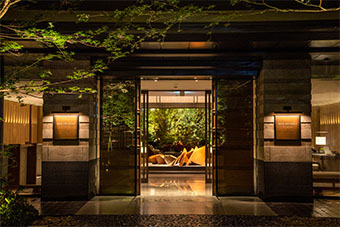
18 Jan Landscape design at Hotel The Mitsui Kyoto
ADF MAGAZINE | By Ellen Boonstra
Many boys entertain delusions of grandeur about their futures. Either they want to be professional athletes or astronauts or rock stars.
Not Shunsaku Miyagi: he wanted to be a gardener. For a boy from Kyoto, who grew up watching gardeners in action around his home near one of the picturesque temples in the area, landscaping and gardening were his lifeblood.
Which is why his latest project, Hotel the Mitsui Kyoto, is like a homecoming for him. The first such luxury hotel in the city’s aorta, the project brings together the talents of specialists like André Fu (interiors), Yohei Akao (the restaurants and spa area), along with Shunsaku Miyagi as the landscape designer extraordinaire. All of them worked under the supervision of Akira Kuryu.
For centuries, the Japanese have cultivated gardens both for pleasure and as pillars of spirituality on the grounds of temples. The hotel’s General Manager Manabu Kusui summarized this special relationship and how it’s become a cornerstone of the brand. “The harmony between the natural environment, scenery and history is a story we can all relate to and is key to the ultimate hotel experience. This is expressed in our brand concept, Embracing Japan’s Beauty.”
The harmony he spoke of is on prominent display in the courtyard garden of this luxury hotel, which boasts 161 guest rooms, 22 of which are suites, including two Onsen Suites and a Presidential Suite. The garden combines a sense of modernity with touches of antiquity.
“The courtyard garden runs east-west, and on the eastern side it connects with the entrance lobby and lounge, which is an expression of modern Kyoto aesthetics,” Shunsaku Miyagi said. “On the western side of the garden, where Forni [the hotel’s Italian restaurant] is located, we can see the more traditional garden aesthetic. Water serves as a form of gradation, running between and connecting the two. One gets a sense of depth when viewing the garden from the lobby; an abstract fusion of tradition and modernity.”
For him, the element of growth and chance looms large in any design for a garden. All such projects are works-in-progress, forever changing and ever evolving with the seasons and elements.
As a professor in the Department of Urban Engineering, part of the Graduate School of Engineering at the University of Tokyo, he has worked on several high-profile projects in the capital, such as the Ginza Six Garden, after returning from the United States. His experiences abroad added to his knowledge, but his Japanese roots still showed in the way he sought not to copy nature but distill its essence. “Even when something has been copied from an organic object, it does not mean it will appear natural. The result may appear like a distillation of the natural world. That’s the connection with the concept of what we call sokkei – the tactile landscape,” he explained.
Forging a harmony between the gardens and buildings, known as teioku ichinyo in Japanese, is an age-old belief in the country that is the root system for the landscape designs at Hotel the Mitsui Kyoto. The hotel opened in November 2020 after a number of coronavirus-spawned delays.
One such vantage point that shows off this Japanese sense of harmony between the buildings and green spaces is the private onsen from where visitors can enjoy a hot bath while viewing the small courtyard garden designed by Miyagi.
The Garden Bar also provides a viewpoint for taking in the landscaped grounds that illustrate a primal truth in philosophy – “Nothing is permanent except change.” – through the way the scenery changes throughout the year: the snowy white cherry blossoms that appear in the spring, the dense greenery of summer, the changing palette of autumn, heavy on brown and gold, as well as the shifting hillocks of snow in shades of polar-bear white during the winter.
By his own reckoning, Miyagi has seen most of the gardens in this impeccably conserved city. Bisected by narrow lanes and a bastion of Japanese traditions like teahouses, Kyoto is a tourism hotspot that has managed to stave off the despoiling aspects of tourism while reaping its riches.
That ancient heritage was both daunting and inspiring for the landscape designer. It forced him to dig deep within himself and his knowledge and experience to come up with something different that embraced the past without slavishly imitating it.
As he explained, “Kyoto has an embarrassment of riches when it comes to traditional Japanese gardens, so it takes a certain amount of bravery to design a new garden in this city. I think that is because any new garden will be compared alongside the historical gardens in the city. So with this courtyard garden I really tried to design a space that had something to offer from every possible viewpoint, which I believe is not something many traditional Kyoto gardens can claim.”
Published:
https://www.adfwebmagazine.jp/en/architect/the-art-of-landscape-design-at-hotel-the-mitsui-kyoto/



